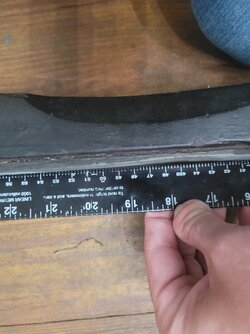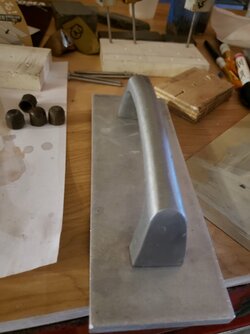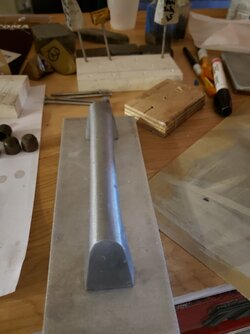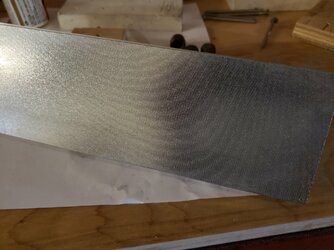I am sure this is already common knowledge to most here but I'm sure there are also some people like me. I tend to be frugal....cheap so i have been using Chinese diamond plates for lapping stones thinking "how different could they be?" I was very wrong. Finally decided to order a 400 atoma. Got the replacement plate because i have access to 3/8 aluminum plate and the means to cut and flatten it. Night and day difference. The chinese diamond plates don't even compare. I also have a dtm that was pretty expensive and that is not even in the same league. Really wish i had gotten one years ago.
You are using an out of date browser. It may not display this or other websites correctly.
You should upgrade or use an alternative browser.
You should upgrade or use an alternative browser.
Atoma
- Thread starter Pack line
- Start date
Depends on what you are doing with them. If you are just lapping water and natural stones, it does not matter that much.
Also depends on the Chinese plate. Chinese plates have also really gone up in price and sometimes for the price difference it is not worth it, especially since you can re skin an Atoma.
Nice handle, but I am not a fan of handles on diamond plates. The trick for diamond plate longevity is Not to use pressure and use lots of water, let the diamonds do the cutting.
If you use pressure it is easy to rip out the diamonds.
Take a cue from Surface Plate Calibration re-lapping services, they dust a large cast iron lapping plate and imbed/roll a light dusting of diamonds on the cast iron and let the weight of the plate do the cutting. They cut granite easily and quickly any extra pressure would dislodge the diamonds.
Also depends on the Chinese plate. Chinese plates have also really gone up in price and sometimes for the price difference it is not worth it, especially since you can re skin an Atoma.
Nice handle, but I am not a fan of handles on diamond plates. The trick for diamond plate longevity is Not to use pressure and use lots of water, let the diamonds do the cutting.
If you use pressure it is easy to rip out the diamonds.
Take a cue from Surface Plate Calibration re-lapping services, they dust a large cast iron lapping plate and imbed/roll a light dusting of diamonds on the cast iron and let the weight of the plate do the cutting. They cut granite easily and quickly any extra pressure would dislodge the diamonds.
Last edited:
Depends on what you are doing with them. If you are just lapping water and natural stones, it does not matter that much.
Also depends on the Chinese plate. Chinese plates have also really gone up in price and sometimes for the price difference it is not worth it, especially since you can re skin an Atoma.
Nice handle, but I am not a fan of handles on diamond plates. The trick for diamond plate longevity is Not to use pressure and use lots of water, let the diamonds do the cutting.
If you use pressure it is easy to rip out the diamonds.
Take a cue from Surface Plate Calibration re-lapping services, they dust a large cast iron lapping plate and imbed/roll a light dusting of diamonds on the cast iron and let the weight of the plate do the cutting. They cut granite easily and quickly any extra pressure would dislodge the diamonds.
Let's not forget the weight of the cast iron surface plate that's doing the lapping. That will provide significant downward pressure. Even a 12" x 12" plate will weigh probably close to 50 pounds. The reason they let the plate do all the work is to ensure even pressure across the full surface. Pushing down even a little harder on one side or the other would create a heavier cut on that side - exactly the opposite of what is desired to get an even and flat surface. Even so, they never get the plates perfect, but they can get within 50 millionths of an inch or less on the smaller plates. That requires a lot more than just rubbing the lapping plate randomly on the surface though. At that level even a stray beam of sunlight or a cool or warm air current can mess up the measurements and geometry of the surface.
Nice job, OP. I've found that buying new plates every year or two is very beneficial if you want to cut fast. Keep some of the older ones for smoothing. Sell the rest for a few bucks. The plates slow down over time as the diamonds lose their sharp corners and dull out.
Last edited:
You've convinced me. My shoulder is wrecked and I have a pretty big, old coarse charnley that needs to be flattened like another 2+mm and I'm not sure I have it in me. Even with the SiC powder over been using. It's a tough rock. I was initially disappointed because it was a smooth as glass but once I lapped a couple mm into it and the grain is like a very fine washita. I have a feeling once it's functional it'll very wick like quickly become one of my favorite pocket knife finishing stones.I am sure this is already common knowledge to most here but I'm sure there are also some people like me. I tend to be frugal....cheap so i have been using Chinese diamond plates for lapping stones thinking "how different could they be?" I was very wrong. Finally decided to order a 400 atoma. Got the replacement plate because i have access to 3/8 aluminum plate and the means to cut and flatten it. Night and day difference. The chinese diamond plates don't even compare. I also have a dtm that was pretty expensive and that is not even in the same league. Really wish i had gotten one years ago.
Pic related is after spending around 40 mins with 60 grit SiC powder on tempered glass. This picture is at a horrible angle as well.

Charnley and LI always have that Washita feeling surface off 60 grit SIC. A quick polish on some 240, then 600 paper smooths it out.You've convinced me. My shoulder is wrecked and I have a pretty big, old coarse charnley that needs to be flattened like another 2+mm and I'm not sure I have it in me. Even with the SiC powder over been using. It's a tough rock. I was initially disappointed because it was a smooth as glass but once I lapped a couple mm into it and the grain is like a very fine washita. I have a feeling once it's functional it'll very wick like quickly become one of my favorite pocket knife finishing stones.
Pic related is after spending around 40 mins with 60 grit SiC powder on tempered glass. This picture is at a horrible angle as well.
View attachment 1526232
A hard Charnley will wear out a 400 Atoma pretty quickly.
- Thread starter
- #6
I definitely would not use on anything harder then a hard ark. But on synths, jnats, slates, works amazing. Been using it to make slurry on my hindo, hence the handle, works well. And the finish is very consistent on the stone.
I am sure this is already common knowledge to most here but I'm sure there are also some people like me. I tend to be frugal....cheap so i have been using Chinese diamond plates for lapping stones thinking "how different could they be?" I was very wrong. Finally decided to order a 400 atoma. Got the replacement plate because i have access to 3/8 aluminum plate and the means to cut and flatten it. Night and day difference. The chinese diamond plates don't even compare. I also have a dtm that was pretty expensive and that is not even in the same league. Really wish i had gotten one years ago.
100% agree. I have two 140x400 atoma combis and they’re easily my most used bit of ‘sharpening’ kit.
The handles are useful not necessarily for getting more pressure, but for applying it evenly. Downsides are; you can’t make a combi, they take up more space, but the big one is that atoma sheets have a lot more life in them than most people think. If you put a completely ‘worn’ atoma plate on a work surface and have the stone in your hand with lots of pressure - you can get a load more use out of them. When you come to remove the sheet try to do it without bending, stick it on something else and use it like that.
- Thread starter
- #8
Most of those contact adhesive will loosen with heat, but i have a long time to go before i need to worry about removing it. Also i have plenty of 3/8 aluminum and more then a few handles if i need them.100% agree. I have two 140x400 atoma combis and they’re easily my most used bit of ‘sharpening’ kit.
The handles are useful not necessarily for getting more pressure, but for applying it evenly. Downsides are; you can’t make a combi, they take up more space, but the big one is that atoma sheets have a lot more life in them than most people think. If you put a completely ‘worn’ atoma plate on a work surface and have the stone in your hand with lots of pressure - you can get a load more use out of them. When you come to remove the sheet try to do it without bending, stick it on something else and use it like that.
Just hoping this thread is helpful to anyone one the fence about getting one. I am definitely a believer now
Most of those contact adhesive will loosen with heat,
They do slightly with atomas, but the sheets are pretty tricky to get off whatever way you spin it, especially without bending them or damaging/scuffing up the plate. Can be done though, and worth trying.
I usually then stick them back to back like this, and you can get a load more life out of them. (Or as you say - another bit of Aluminium if you've only got one sheet at a time).
- Thread starter
- #11
Definitely agree. 400 works great to flatten and clean coarse stones during bevel setting. Most stones i am flattening i do SiC 60, SiC 220, atoma 400, then a beat to hell cheap diamond plate. I don't generally use diamond plates to make slurry on finishers but have had good success with the 400 on a hindo for slurry. I use no pressure, barely the weight of the plate, similar to mikawa or tomo nagura. Then again i would not rate a hindo as a finisher, not for razors anyway.If I have got a lot of lapping to do, I will use SiC wet/dry sandpaper backed by a granite tile. Once the stone is flat, I use a Atoma 1200 grit plate to maintain the flatness and also to create slurry. I would consider 400 grit to be too coarse for creating a slurry on a finishing stone.
It depends on the stone. 400 is absolutely fine on softer stones like slates and cotis. The scratches are removed almost immediately by the blade.If I have got a lot of lapping to do, I will use SiC wet/dry sandpaper backed by a granite tile. Once the stone is flat, I use a Atoma 1200 grit plate to maintain the flatness and also to create slurry. I would consider 400 grit to be too coarse for creating a slurry on a finishing stone.
On hard stones like trans Arks, CF, LI etc, I would want to finish finer.
Last edited:
Atoma plates are convenient. I use them mainly for cleaning up my shapton glass stones and making Tomo slurry on a Jnat.
If I’m doing serious lapping or want a stone really flat I like to use WD sandpaper on a certified granite surface plate. It’s bulky but it’s a big surface and super flat.
If I’m doing serious lapping or want a stone really flat I like to use WD sandpaper on a certified granite surface plate. It’s bulky but it’s a big surface and super flat.
I have been using my Atoma 1200 and following it with a minimal work on a natural stone for quick kitchen knife sharpening lately. In my opinion the edge and edge retention is really good. Compared to my Venev vetrified diamond plates they are quite close in performance on soft stainless knifes.
My Atoma 400 does not get near any of my knifes, but the 1200 can be a really nice addition to other wet stones. Most of the time i grab my atoma 1200 before one of my shapton glass for a quick edge tuneup.
My biggest problem in my house is rolled edges. So being able to do this fast, with good results is important to me.
When i have time i prefer to use other stones, and i do not have any expensive japanese knifes, so there is that
My Atoma 400 does not get near any of my knifes, but the 1200 can be a really nice addition to other wet stones. Most of the time i grab my atoma 1200 before one of my shapton glass for a quick edge tuneup.
My biggest problem in my house is rolled edges. So being able to do this fast, with good results is important to me.
When i have time i prefer to use other stones, and i do not have any expensive japanese knifes, so there is that
Similar threads
- Replies
- 39
- Views
- 2K



